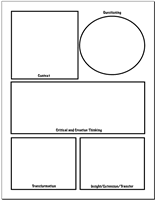Planning Using the Comic Format
How can I design an engaging, inquiry-rich environment, yet still address the standards?
 Rather than working with teachers to rehash or reorganize traditional lessons and assignments, think of new ways to plan for learning experiences by designing an environment rich in resources, tools, and opportunities for critical and creative thinking. The goal in transforming assignments is to turn teacher-directed assignment into engaging, learner-centered inquiry.
Rather than working with teachers to rehash or reorganize traditional lessons and assignments, think of new ways to plan for learning experiences by designing an environment rich in resources, tools, and opportunities for critical and creative thinking. The goal in transforming assignments is to turn teacher-directed assignment into engaging, learner-centered inquiry.
Annette Lamb developed a new way to think about student inquiry that can be helpful in transforming traditional activities. As you explore the inquiry examples, you'll notice that some of the inquiry examples follow a specific child through the inquiry process. These inquiry Bubbles, Colonial, Butterfly, Civil Rights, Utopian Literature, and Spanish Inquiry.
For some cool software to create comics, go to Comic Life.
Context. Inquiry projects begin with a meaningful context, powerful idea, or authentic problem. Rather than the teacher dictating the direction and assignment, young people are given resources and tools to discover areas of interest and concern.
How will you develop an engaging, authentic environment that hooks students and provides the resources and tools that stimulate inquiry?
Questioning. Young people can generate powerful questions. The key is helping young people learn to ask "how" and "why" questions that lead to investigations requiring high level thinking skills. Educators can model these types of questions and provide guidance as students learn to become effective questioners. Remind students that the most interesting questions are often difficult to answer and generate multiple solutions and opportunities for new investigations.
How will you involve students creating powerful questions?
Critical and Creative Thinking. Rather than focusing on specific activities that students will complete, consider about the type of thinking that is required to address questions and solve problems. By encouraging students to think both critically and creatively, it's easy to design environments to meet diverse learning needs. Students naturally apply multiple intelligences as they read, visualize, listen, organize, watch, and create. Rather than simply examining and reporting the facts, can we ask students to forecast the future, debate an issue, or write from a particular perspective? Unfortunately, many projects end at this point with a simple reporting of facts.
How can you design learning environments that promote critical and creative thinking?
Transformation. Synergy comes when students create something that becomes more than the individual parts. Students synthesize information and formulate new possibilities. Collaboration is a wonderful example of synergy in action. Students are involved with comparing their data with others and create something new and original to share. They might interact with children of different ages, teachers, or members of the community. A "deep thinking" project encourages young people to transform their new knowledge into something they can connect, compare, and share.
How can you buld a transformational aspect into the inquiry?
Insight/Extension/Transfer. Young people are encouraged to reflect on their experience, think about the insights they've gained, extend their understandings, and transfer their learning to new situations and inquiries.
What can you do to ensure that this learning experience becomes the foundation for independent thought and future inquiry?
Explore a couple examples: Leonardo & Me and Black Holes.
